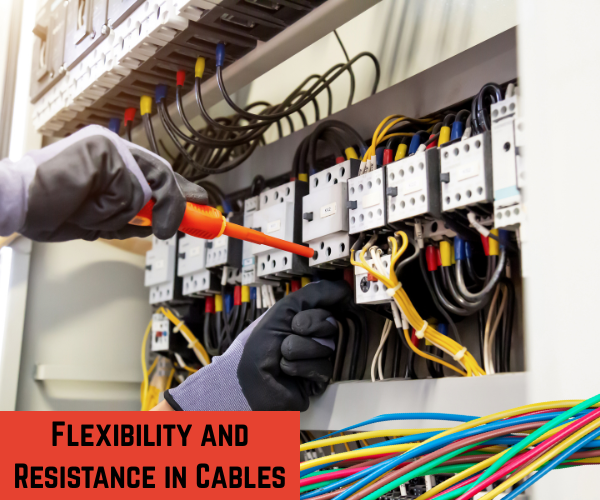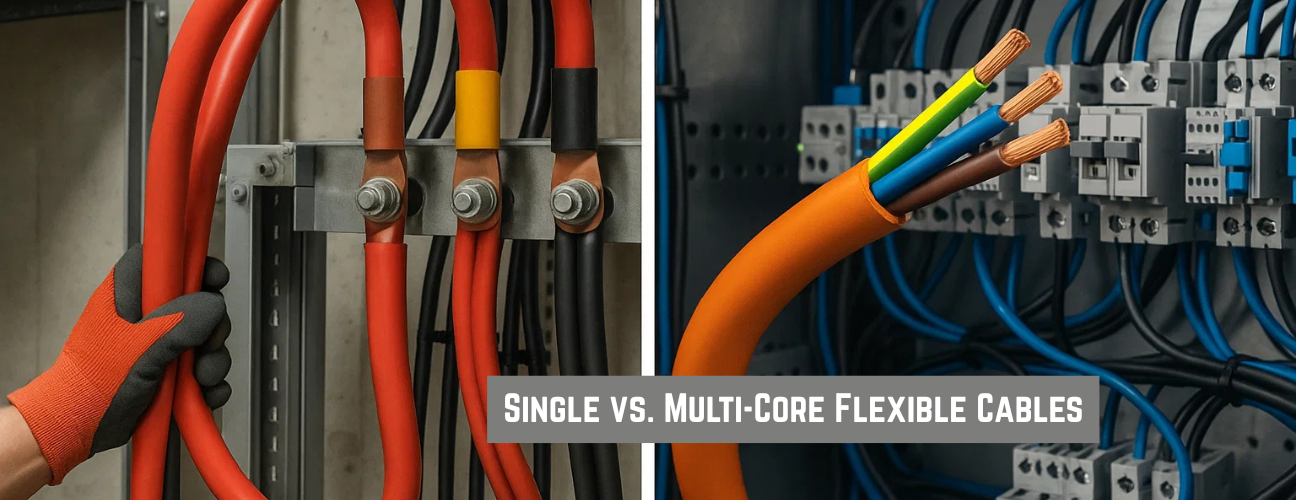Table of Contents
In any electrical installation – be it automation, power distribution or machine wiring – the choice of cable impacts performance, safety and longevity. Among the most common options, Single Core and Multi-Core Flexible Cables are frequently used in modern infrastructure due to their durability and ease of installation. Selecting between the two requires a deeper understanding of the project’s technical demands, mechanical environment and installation layout.
Whether you’re integrating a Flexible electrical wire into a control cabinet or using Flexible Copper Cables for dynamic industrial applications, each core type serves a specific role. The challenge lies in determining which configuration best suits the operational, spatial and electrical needs of your project.
This article delves into the differences, advantages and ideal usage scenarios of single core flexible cable and multicore flexible cables, offering clarity on when and why each type should be chosen.
Understanding Cable Core Structures and Their Roles
The structure of a cable’s core directly affects its functionality. A Single Core Flexible Cable comprises one insulated conductor, usually made from high conductivity flexible wires and is typically used for straightforward applications such as panel wiring or internal machine connections.
Conversely, a Multicore Flexible Cable consists of two or more insulated conductors bundled together within a single sheath. This structure simplifies complex wiring by consolidating multiple connections into a unified format. These cables may range from Three Core Flexible Cable variants to more elaborate designs depending on system requirements.
The choice between single and multicore depends not just on current capacity or insulation but also on practical considerations such as routing complexity, frequency of motion, electromagnetic interference (EMI) and space constraints.
Application Criteria: When to Use Single Core Flexible Cable
Single core flexible cables are generally preferred in scenarios requiring straightforward routing, modular panel layouts or environments with minimal physical stress. Some of the most common applications include:
- Internal Panel Wiring: Their flexibility makes them easy to manage within control panels, especially when neatly routed using trunking or cable ducts.
- Short Distance Power Distribution: For systems where multiple cables run in parallel, single-core options allow better heat dissipation.
- Earthing and Bonding Systems: These systems require direct paths for current flow, making single core ideal for grounding applications.
One of the key benefits is thermal management. Since each conductor is individually exposed (rather than sheathed together), it offers better air flow, enhancing heat dissipation. This can be crucial in high-current environments or installations where ambient temperatures are high.
Additionally, single core cables can be easier to replace individually, making them suitable for installations with frequent maintenance schedules.
Testimonials
There is difference between distributor and retailer…By their pricing strategy they seems a retailer or they are short of business and want big profit in one go…Better to go with other cable vendors
Application Criteria: When to Use Multi-Core Flexible Cables
Multicore flexible cables offer an efficient wiring solution where multiple signal or power lines need to be carried over a common path. These cables are particularly effective in compact or mobile systems where space is limited or cable movement is frequent.
Use cases include:
- Machine Tool Wiring: Complex machines require multiple connections between control units and operational components. Multicore cables reduce clutter.
- Instrumentation and Control Systems: They allow organized wiring between sensors, controllers and power supplies.
- Power Transmission in Small Spaces: A three core flexible cable is ideal for balanced three-phase systems or residential wiring where neatness and safety are essential.
Multicore cables help avoid cross-interference between wires by using shielding techniques or specific twisting patterns, depending on application. Moreover, with Flexible electrical wiring solutions, such as those in Havells flexible wiring systems, these cables support repeated bending or flexing, ideal for robotic arms or conveyor systems.
Mechanical Considerations: Flexibility and Movement Resistance

Flexibility is a critical parameter in choosing the correct type of cable. Flexible electrical wires used in robotics, automation and CNC machinery must tolerate continuous motion, tight bending radii and mechanical stress.
In such settings, copper flexible cables – whether single or multicore – offer high flexibility due to finely stranded conductor structures. Multicore flexible cables, in particular, can be jacketed with thermoplastic or elastomeric compounds that offer abrasion resistance, oil resistance and fire retardancy.
If the application involves continuous motion in multiple directions, such as drag chains or robotic assemblies, multicore cables with reinforced sheathing and bending support may be the better choice. However, if movement is linear and isolated to a single conductor, single-core flexible cable may suffice.
Space, Routing and Aesthetic Considerations
Installation space plays a large role in cable selection. For cramped panels or embedded conduits, multicore cables offer a streamlined appearance and reduced clutter. Instead of managing five separate cables, an installer can route a single multicore cable, reducing labor and improving system aesthetics.
In contrast, single-core cables are more adaptable for systems requiring isolated routing paths or custom trunking systems. They’re easier to loop, bend or reroute without disturbing other conductors. Their smaller cross-sectional footprint also facilitates efficient heat distribution when laid out in spacing-compliant ducts.
Electrical Load and Current Distribution
Choosing the right core type also hinges on load management. Flexible electrical cables must support rated voltage and current without overheating or causing voltage drop. Single-core cables typically carry more current per conductor due to better cooling and spacing options.
In contrast, multicore cables concentrate conductors into a smaller area, which may lead to higher internal temperatures and derating in high-load applications. Manufacturers often provide de-rating charts to adjust current capacity based on installation methods.
When precise load management and minimal temperature rise are critical – such as in power cabinets or switchgear – single core flexible cables may offer better performance. For low-to-medium load control circuits or signal transmission, multicore options are generally sufficient and more practical.
Shielding, Noise Isolation and Interference Mitigation
In environments with high EMI or RF interference, cable shielding is essential. Multicore cables often come with overall shields (like aluminum foil or braided copper) to prevent noise from affecting signal integrity. This makes them ideal for instrumentation, audio, data communication and PLC control systems.
While single-core cables can also be shielded individually, the cost and space implications rise with each added wire. Therefore, for signal integrity and efficient EMI protection, multicore flexible cables are typically preferred.
Ease of Maintenance and Fault Diagnosis
One advantage of single-core cable installations is simplified maintenance. If one line fails or needs upgrading, only that conductor needs replacement. In a multicore setup, isolating and replacing individual conductors may be more complex, especially if the outer sheath must be cut open.
For projects where regular modifications, diagnostics or expansions are expected, single-core cables allow modular design. In contrast, multicore systems offer convenience where systems are fixed or enclosed in inaccessible pathways.
Cost and Procurement Efficiency
From a procurement standpoint, multicore cables often reduce overall material costs by bundling multiple conductors into one product. This translates into lower installation and labor costs. However, in high-power applications requiring large conductor sizes, single-core cables may be more cost-efficient due to reduced derating and easier scalability.
Cost should always be weighed against performance, safety and long-term maintenance requirements. When sourcing flexible cables, it’s vital to match the conductor type, insulation and core count with the electrical and mechanical load profiles.
Conclusion
The choice between Single Core and Multi-Core Flexible Cables is a function of design complexity, space availability, electrical load, mechanical movement and future maintenance needs. While Single Core Flexible Cable excels in heat management and modular systems, Multicore Flexible Cable offers streamlined installation, compact routing and better signal management in control-heavy systems.
Whether integrating Flexible Copper Cables in a power distribution panel or laying Three Core Flexible Cable across a workshop floor, selecting the right core configuration is fundamental to system reliability. By understanding each cable type’s advantages and limitations, professionals can design smarter, safer and more efficient electrical projects.
Table of Contents


